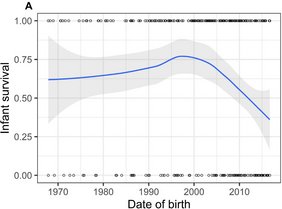Mountain Gorilla Population Growth
Categories: Journal no. 66, Gorilla Numbers, Censuses, Gorilla Groups, Behaviour, Rwanda, Volcano National Park, Mountain Gorilla

Survival across the study through infancy (3.5 years) based on the individual's date of birth. The dark line indicates smoothed conditional means using the 'loess' function, the gray shading indicates 95 % confidence intervals, and the circles indicate individual infants (0 = died, 1 = survived). Data excludes stillborn offspring. The coloured shading on the X axis indicates periods (A-D) of the study. (© Robin Morrison)
New research from the Dian Fossey Gorilla Fund analyses more than 50 years of demographic data to examine factors influencing variability in the growth rate of the mountain gorilla population and what this may mean for their future conservation.
Mountain gorillas are a rare conservation success story. The subspecies was on the verge of extinction in the early 1980s but through long-term investment by the governments of Rwanda, Uganda and the Democratic Republic of the Congo as well as conservation organisations like the Dian Fossey Gorilla Fund, they are currently the only great ape whose numbers are increasing. But with approximately 1,000 individuals left, they remain a highly conservation-dependent subspecies.
Historically, as a result of the heavy poaching in the 1970s and early 1980s, the mountain gorilla group density was low in the area of the Volcanoes National Park. From the mid-1980s, the mountain gorilla population in Rwanda began a slow recovery, demonstrating the benefits of strengthened conservation practices, which included anti-poaching patrols, daily monitoring, community engagement and veterinary care. This allowed the population to grow consistently each year throughout the 1980s and 1990s. During this time groups interacted infrequently, maybe every other month, and were very stable with few changes in leadership and group splits.
By the early 2000s many of the monitored groups had grown considerably, with one reaching 65 individuals, which is around six times larger than the average mountain gorilla group. Despite the growing population, the density of groups and frequency of inter-group encounters remained relatively stable.
In 2007, this stability began to change, as these now very large groups began to split from each other. The group density tripled in the space of only two years, as young males left to form their own groups. This increase led to more spatial overlap and group interactions. Such interactions range from tolerant to highly aggressive, and this aggression can even be lethal, particularly for adult males who are usually involved in this violence, and infants which can often be the targets of violence from out-group males.
An earlier study (Caillaud et al. 2020) had revealed that these increased interaction rates resulted in higher male and infant mortality, contributing to a significant slowing of the population growth rate. However, the authors reported that mortality alone did not explain this pattern.
In the new study, further analysis revealed that changes in female reproduction also played a role. The increase in intergroup encounters gave females more opportunities to move between groups. But these moves were associated with delays in reproduction, specifically the period between successful births. In mountain gorillas, infants are usually spaced about four years apart but changing groups one time extended this interval by nearly eight months, while changing groups multiple times led to an 18-month extension.
Females' choice of which group to live in is an important part of gorilla life history but is largely limited to when groups interact with each other. Historically, the low rates of group interactions meant that females had relatively few opportunities to move, as they generally only transfer when they are not pregnant or have a dependent offspring. The significant increase in group interactions provided us with the first opportunity to study the implications for females that change groups multiple times.
The study shows that female movement patterns and the reproductive consequences of these follow broader trends driven by social dynamics across the population. It adds to our growing understanding of how social dynamics can impact conservation, particularly when groups are living at a high density.
Fortunately, over the last several years, the groups have been able to spread out, suggesting this period of group instability, high mortality and slowed reproduction may be coming to an end. Infant mortality as well as female transfer rates are already beginning to return to what was more typical in the 1980s and 1990s. However, the results underscore the challenges facing the population as it continues to grow within a limited habitat.
Extrinsic factors, such as climate change or poaching, are often more commonly highlighted as conservation threats but these data highlight some of the intrinsic challenges species may face as habitat shrinks. This is critical information that can help inform longer-term conservation strategies to ensure the continued growth of the population.
Robin Morrison, Dian Fossey Gorilla Fund
Original article:
Morrison, R. E., Hirwa, J. P., Ndagijimana, F., Vecellio, V., Eckardt, W., Stoinski, T. S. (2022): Cascading effects of social dynamics on the reproduction, survival, and population growth of mountain gorilla. Journal of Animal Conservation. https://doi.org/10.1111/acv.12830
Reference
Caillaud, D. et al. (2020): Violent encounters between social units hinder the growth of a high-density mountain gorilla population. Science Advances 6, eaba0724
